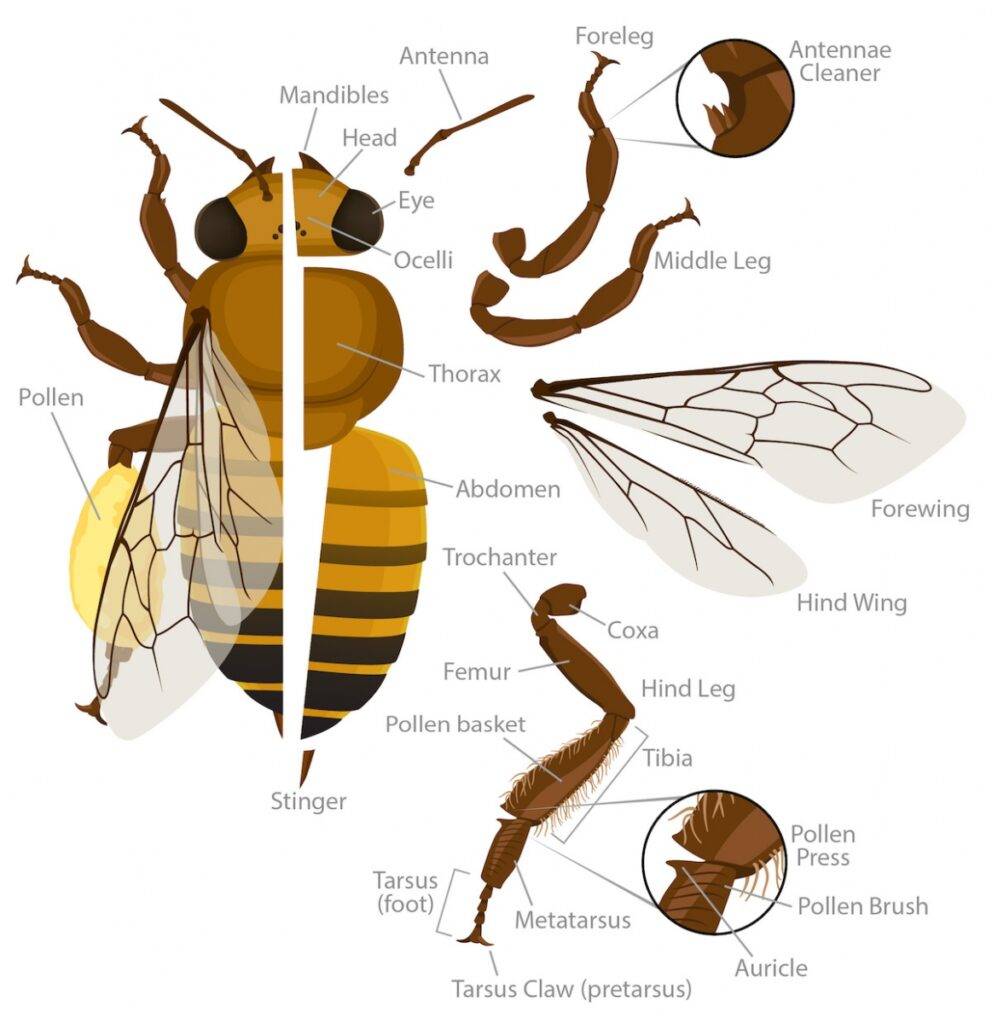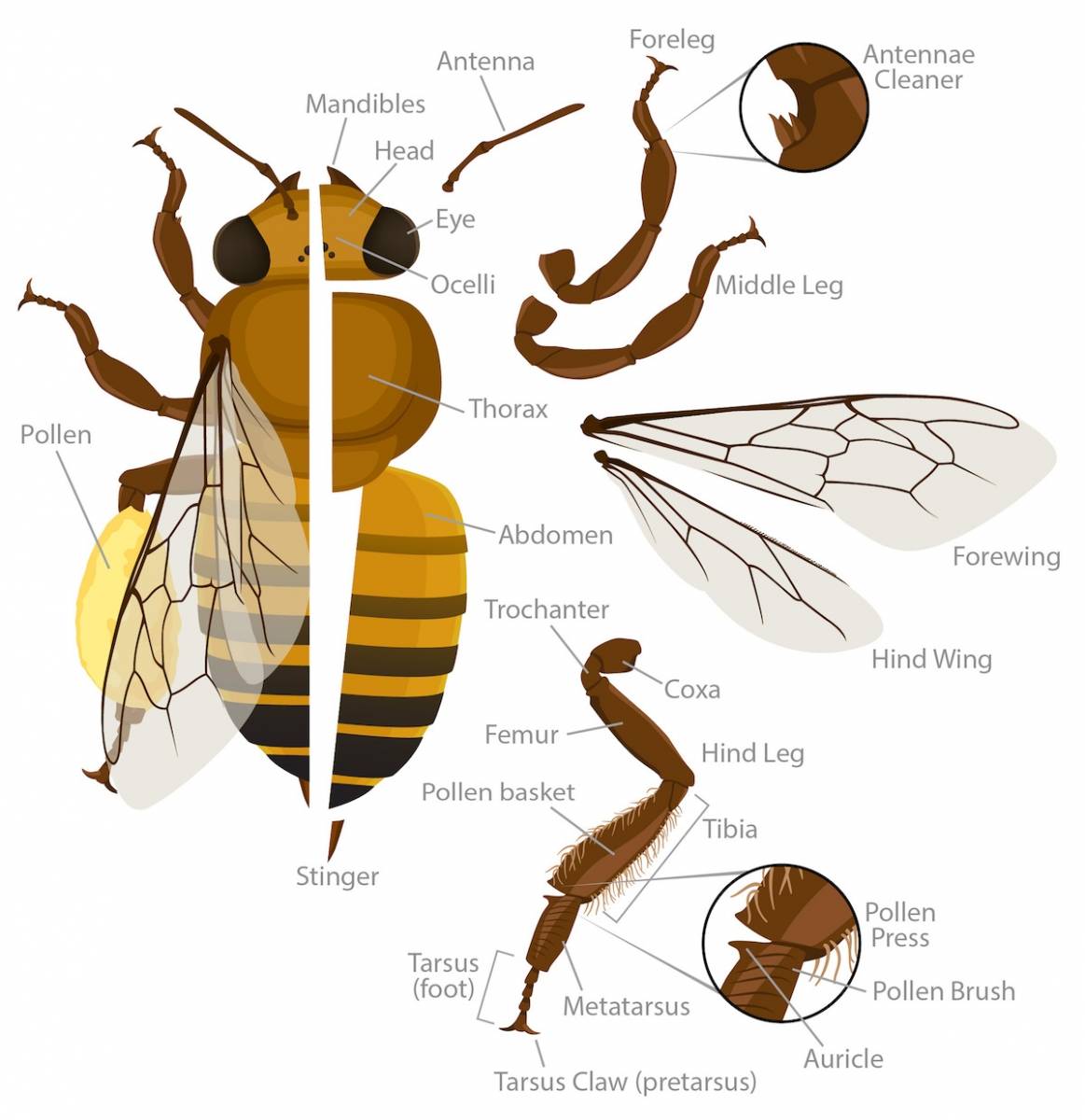How many wings do bees have? You might think the answer is obvious. Many assume two, others more. Like other bee anatomy, this explanation is a bit more complicated.
Basics of Honey Bee Anatomy
Like all insects, bees have three distinct parts: a head, abdomen, and thorax. Bees have six legs, three on each side of the thorax. It also has a long tongue (proboscis) that acts as a straw, mainly for water and nectar.
The stinger is located at the very end of its abdomen. This is used to determine if the bees themselves or the entire colony are at risk.

Bees also have two antennae, which they use for smell and touch. Each side of the bee’s head has large compound eyes, which are made up of many small eyes grouped together.
Bee wings
The wings of bees play an important role in their scientific name. Bees belong to the order Hymenoptera. This is a word from Greek – literally it means membrane (hymen) wing (ptera).
Bee wings are made of a fibrous substance called chitin. Chitin is the same material that makes up the body wall – the wings are extensions of the bee’s exoskeleton.
If you look at a bee, you might think it only has two wings. When a bee rests, its wings gently overlap. If you look closely, you’ll see that there are four of them in total.
Bees have two pairs of wings on each side of their thorax. They have a pair of forewings that are almost the same length as the abdomen and a set of smaller hindwings.
In flight, the two pairs of wings combine to form a larger wing on each side. This is achieved through a series of hooks called humuli. These humuli are located on the edges of the hind wings and snap into grooves in the trailing edges of the forewings. Once the bees have landed, they are released.
In addition to helping the bees fly, the wings also help the bees ventilate the hive, which reduces the moisture content of the honey.
Flight muscles
The wings of bees are powered by the longitudinal and vertical muscles of the thorax. This pair of muscles occupies almost the entire abdomen and is necessary for bees to fly.
When the longitudinal muscles contract, the thorax rises, allowing the wings to descend. The vertical muscles work in the opposite direction. As they contract, the height of the chest shortens and the wings lift.
This muscle movement occurs multiple times with nerve impulses, which allows bees to fly at incredible speeds. Here are some facts about bee flight:
- Unloaded and fully loaded bees fly at speeds of 7.5 and 6.5 meters per second, respectively
- The bee’s wing beat rate is about 125-130 times per second
The effect of temperature on flight
When the wing muscle temperature drops below 96.8 degrees Fahrenheit, (36 degrees Celsius) they cannot function, so the bees cannot fly. Since bees are cold-blooded, they have to figure out how to increase it on their own.
During flight, the temperature is maintained by the wing muscles – each contraction generates heat. It is specified to stay between 96.8 and 111.2 degrees Fahrenheit (36 and 44 degrees Celsius).
While resting, the body temperature of the bees adjusts to the environment. Honeybees use a shaking mechanism to raise the temperature of their flight muscles high enough to take off.
You can observe this in a grounded bee as its abdomen expands to help heat up the flight muscles. This pumping rate can be measured and provide information about the bee’s body temperature. It takes a few seconds to fifteen minutes to reach the favorable and necessary flight marks.
Bees generally do not venture outside when ambient temperatures drop below 50 degrees Fahrenheit (10 degrees Celsius). However, when food supplies are scarce, the queen will leave the nest at cooler temperatures. Under these difficult conditions, bees change flight altitude to take advantage of temperature differences in the air.
In summary
The mechanics of hooking and heating bee wings are complex but extremely important for understanding their anatomy. If you look at a bee in flight, you would assume that a bee only has two wings.
Bees have four wings – a set of large front wings and smaller hind wings. They also act as two more powerful wings when the Humuli join seamlessly together.

Leave a Reply
You must be logged in to post a comment.